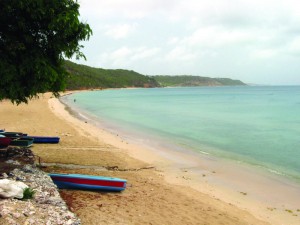
This week, our coverage ofAnguilla’s history continues from where we left off. In 1745 the French inSt Martinwere understandably upset by the Anguillian’s invasion of their island. In retaliation, they landed 150 men on the north coast ofAnguilla.
A popular story, retold when I began my research, claimed that the invading force landed their forces nearCrocusBayon a beach which was later named for the invader’s leader, M. DeLaTouche. In truth,KatoucheBaydoes not derive its name from the invasion and this oft-repeated story is the creation of a British Cartographer who visitedAnguillain the 20th century.KatoucheBayis not named for the invasion, but after the French word, Cadeaux, which means gift.

In fact, the invading force landed onCrocusBaywhich was alsoAnguilla’s main town. The ill-advised landing place is surrounded by hills. Advised of the attack, Governor Hodge ofAnguillarallied and advised his men:
Gentlemen, I am an utter stranger to all manner of military discipline, so have nothing to recommend to you, but load and fire as fast you can, and stand by one another in the defense of your country; so God bless you
According to a contemporary account, 150Anguillamilitia repelled the force in only fifteen minutes. 32 Frenchmen were killed, 25 injured (including M. DeLaTouche) and 50 taken as prisoners.
On the 21st instant, early in the morning, we were surprised by a fleet of French, consisting of two Men-of-War, one of 36 guns, the other of 32, with 3 privateers, and two Dutch vessels as tenders… Their success in landing was a great encouragement to them, and a great discouragement to us: our whole force being 97 men only. These our lieutenant governor, Arthur Hodge, formed into three divisions, and posted them in a very narrow path by which the French were to pass secured with breastworks, the first of which would contain but 22 men, commanded by Captain Richardson. These engaged the enemy, firing by platoons regularly, and with so true an aim that every shot took pace and the French fell so fast, that in less than ten minutes they lost courage, and fled with precipitation, having in this short action at least 160 men killed and wounded, and drowned in getting into their boats.
We expected a fresh onset the next day, but it seems they had a job of it for they went away quietly. We have buried 35 dead, and are daily in search of such as have hid themselves in the bushes, or died there of their wounds, which latter we believe, by the stench to be many, but can give no certain account of them, nor of the drowned. …
Every dead man had in his pockets nettles, or small lines, for pinioning our Negroes. We had not one man hurt, and have got by this expedition, besides two pair of their colours, a great many fine buccaneer guns, cartouch boxes, etc, which they left behind, and with which we intend to arm our most trusty and sensible Negroes to strengthen our island.
In 1747, Governor Hodge travelled toEnglandto ask parliament to allow Anguilla to keepSt. Martin. His requests were unsuccessful and the Treaty of Aix-la-Chappelle in 1748 confirmedSt. Martinas half-French/half-Dutch.
About the author: Lillian Azevedo spent three years living and researching Anguilla’s history for a PhD in Maritime Archaeology and Heritage Management from the University of Southampton in England.










